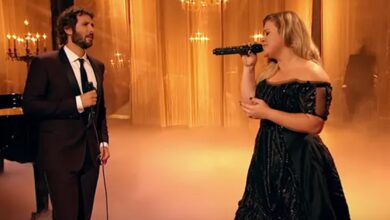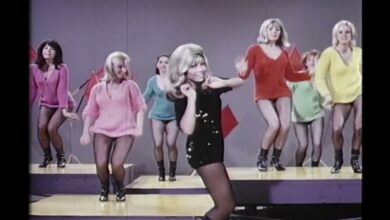Nancy Sinatra’s ‘These Boots Are Made for Walkin’’ Dominates the Charts and Redefines Female Swagger in 1966
In January 1966, the music world was shaken by a voice that didn’t just sing—it strutted. Nancy Sinatra’s “These Boots Are Made for Walkin’” exploded onto the airwaves with an irresistible mix of sass, style, and stomp. It wasn’t just a hit—it was a statement. Within weeks of its release, the song climbed to No. 1 on the Billboard Hot 100 and held court in countries across Europe, becoming a global phenomenon. Backed by a hypnotic bass line, sharp brass, and Sinatra’s cool, commanding vocals, the single didn’t just capture the sound of a moment—it gave voice to a growing wave of female empowerment in pop music. It was a crossover success that helped rewrite the rules for what women in music could say—and how loudly they could say it.
Nancy Sinatra, daughter of the legendary Frank Sinatra, was no overnight success. Born in 1940 in Jersey City, New Jersey, she grew up in the formidable shadow of her father’s fame, but that legacy came with its burdens. Despite a few early recording attempts in the late ’50s and early ’60s, her career struggled to take off. She was on the verge of being dropped by her label when producer Lee Hazlewood entered the picture. Unlike others, Hazlewood saw a spark in Nancy—not just a surname, but a sharp-edged persona waiting to be unveiled. With her petite stature, platinum blonde hair, and dramatic eye makeup, she projected the image of a doll—but Hazlewood helped her find a voice with grit, swing, and unmistakable cool.
“These Boots Are Made for Walkin’” was written by Hazlewood himself, originally intended for a male singer—possibly even for himself. But it was Nancy who insisted the lyrics would be more impactful coming from a woman. The song’s lyrics brim with biting sarcasm and a threat wrapped in a tease: “You keep lyin’ when you oughta be truthin’…” It was less a love song and more a strut through emotional independence, a kiss-off anthem to dishonesty and control. In hindsight, the track captured the spirit of the era—poised at the edge of the sexual revolution and second-wave feminism—but at the time, it was simply bracingly fresh. Sinatra’s insistence on keeping the song for herself marked the turning point in her artistic identity.
The production of “These Boots Are Made for Walkin’” is as sharp and stylish as its lead performer. Recorded at Western Recorders in Hollywood, the track featured members of the legendary “Wrecking Crew”—including Chuck Berghofer on that unmistakable walking bass line. Hazlewood’s production was cinematic and sly, with a layered sound that combined swing, country, pop, and rock. The arrangement marched with military precision but never felt rigid. Sinatra’s vocal delivery was deliberately flat and assertive—unapologetically devoid of melodrama, her voice laced with dry wit. Her performance wasn’t about showing off range; it was about control, posture, and poise.
Upon its release, the single was an instant success. It shot to the top of the Billboard Hot 100 and reached No. 1 in the UK Singles Chart. In a male-dominated music world, Nancy Sinatra’s boots stomped their way to the top with unapologetic attitude. The song sold over a million copies in the U.S. alone, earning Sinatra a gold disc. It also earned her a Grammy nomination and made her a household name. But beyond awards and sales, the song sparked widespread cultural recognition. It was played on jukeboxes, danced to in clubs, and mimicked on stages and in living rooms across the country.
Culturally, “These Boots Are Made for Walkin’” was a watershed moment. It wasn’t just a song—it was a swagger. The single’s success helped redefine the image of the female pop star. No longer demure or deferential, Nancy stood tall in her go-go boots and stared the camera down. She became a fashion icon overnight, with miniskirts and thigh-high boots becoming emblems of the era. The song’s message—that women could leave, reject, and demand better—resonated deeply in a time when traditional gender roles were being challenged. It wasn’t just catchy; it was catalytic.
For Nancy Sinatra, the song opened the floodgates. No longer just “Frank’s daughter,” she stepped into her own stardom. In its wake came a string of successful singles, including “Sugar Town,” “How Does That Grab You, Darlin’?” and the haunting duet with her father, “Somethin’ Stupid.” The boots had kicked down the door, and Nancy walked through it into international fame. She toured Europe and Asia, starred in films alongside Elvis Presley and Peter Fonda, and carved out a unique space in the mid-60s pop scene.
The track also left a sizable footprint on pop music as a whole. It inspired a wave of attitude-driven songs from female artists, who now saw space to express confidence, anger, and rebellion. Artists like Cher, Dusty Springfield, and later, Blondie’s Debbie Harry, carried echoes of Nancy’s bold persona. Even Madonna, decades later, would channel that same sense of unshakable poise. The song’s cool, detached vocal delivery also influenced the vocal stylings of the upcoming new wave and punk movements.
Not surprisingly, “These Boots Are Made for Walkin’” has been covered countless times—by artists as varied as Loretta Lynn, Geri Halliwell, Billy Ray Cyrus, and Jessica Simpson. Each rendition brought its own twist, but none quite captured the original’s perfect blend of wit, bite, and beat. Jessica Simpson’s 2005 version, tied to the Dukes of Hazzard reboot, introduced the song to a new generation—but with a glossy, hyper-sexualized tone far removed from Nancy’s wry coolness. Still, the homage underscored the song’s enduring appeal across decades and styles.
At the time of the song’s release, Nancy was also navigating complex personal terrain—balancing sudden fame with the weight of expectations tied to her famous last name. But instead of being overshadowed by her lineage, she subverted it. Rather than crooning in a torch-song style like her father, she opted for snarl and swing. She played the femme fatale but never the victim, and in doing so, she created a persona all her own. Her success wasn’t just a win for herself—it was a victory for every artist trying to carve out identity in the industry’s crowded corridors.
Decades later, “These Boots Are Made for Walkin’” remains a staple on classic pop and oldies stations. It appears on countless “Best of the ’60s” compilations and consistently ranks on lists of the greatest songs of all time. Rolling Stone, VH1, and NPR have all highlighted its cultural importance. It’s the kind of track that isn’t just remembered—it’s referenced, reenacted, and repurposed in film, television, fashion, and protest.
Its influence echoes in how future female artists approached their image and sound. It normalized assertiveness, flirtation, and emotional honesty in female pop songs. The boots weren’t just walking—they were kicking down the old constructs of how women were expected to behave in music and media. The production style—with its pulsing bass and talk-sung vocal—would influence decades of storytelling-pop.
In later years, Nancy Sinatra would be celebrated for her singular voice in pop history. While her later works never quite eclipsed the impact of “Boots,” she enjoyed a long career, with resurgences in interest thanks to Quentin Tarantino’s use of her song “Bang Bang (My Baby Shot Me Down)” in Kill Bill Vol. 1. The legacy of “Boots” became even more pronounced with time, marking her as one of the few artists who turned a single hit into an entire aesthetic—and an anthem for assertive women everywhere.
“These Boots Are Made for Walkin’” stands today not just as a great pop song but as a cultural inflection point. It reshaped how female artists could express agency, how pop music could embrace both sarcasm and sensuality, and how style could be a form of rebellion. It remains an unforgettable anthem for independence, wrapped in a rhythm that still dares listeners to strut a little taller.



